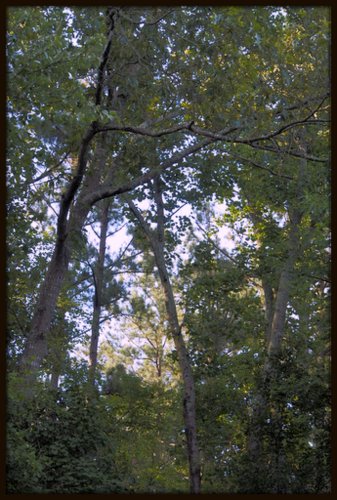An old spiderweb, its occupant long gone, glows in the sunlight of a late summer afternoon along Piney Woods Church Road.
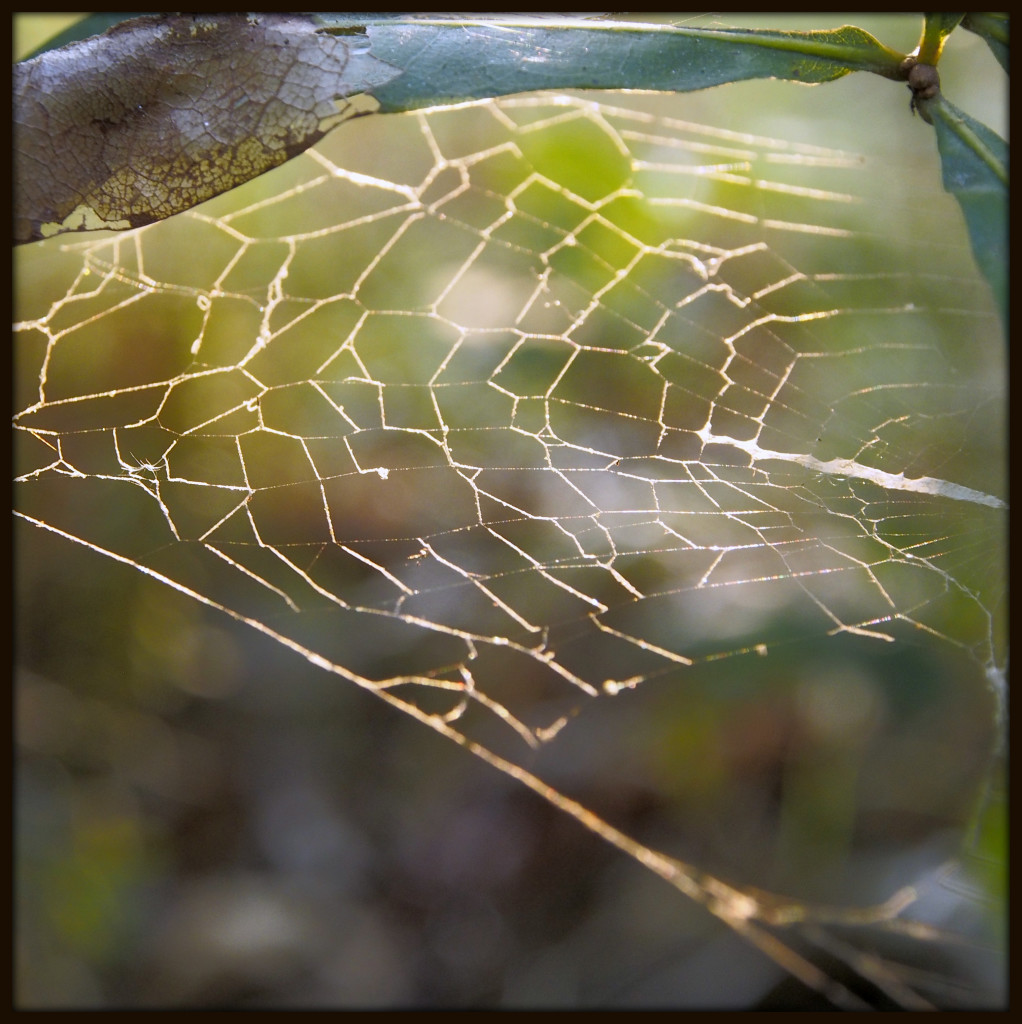
An old spiderweb, its occupant long gone, glows in the sunlight of a late summer afternoon along Piney Woods Church Road.

On my walk this afternoon, I glimpsed for the second time a Flatid Planthopper (Anormenis chloris), a tiny white critter less than a quarter inch in length. It is frightfully difficult to get them into focus (the first time was a complete failure) because of their blindingly white appearance and lack of distinctive features to focus on. Once onto my efforts with the camera, this particular planthopper made a halfhearted attempt and evasion, turning to face away from me. At last, I managed to get a few photos in focus. The Flatid Planthopper feeds on the sap of various shrubs and trees, though it is not considered a garden pest.
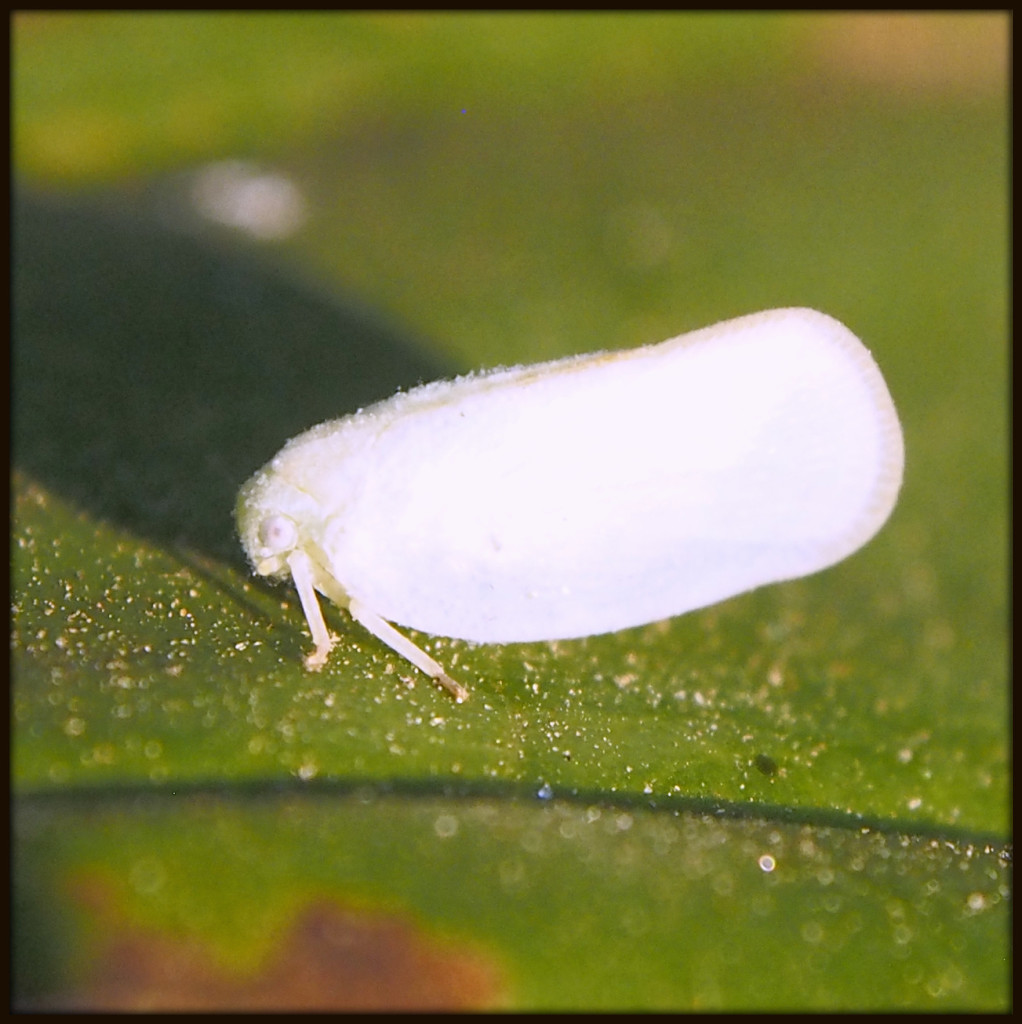
I know this fly looks frightfully close to a common housefly (I am confident it isn’t, but am still working on the ID). I posted earlier today that I tend to balk at posting flies. But I find this fly beautiful, in a flyish way. I also appreciate the late afternoon shadow cast by the fly onto the leaf where it rests. So I am justifying including it here.
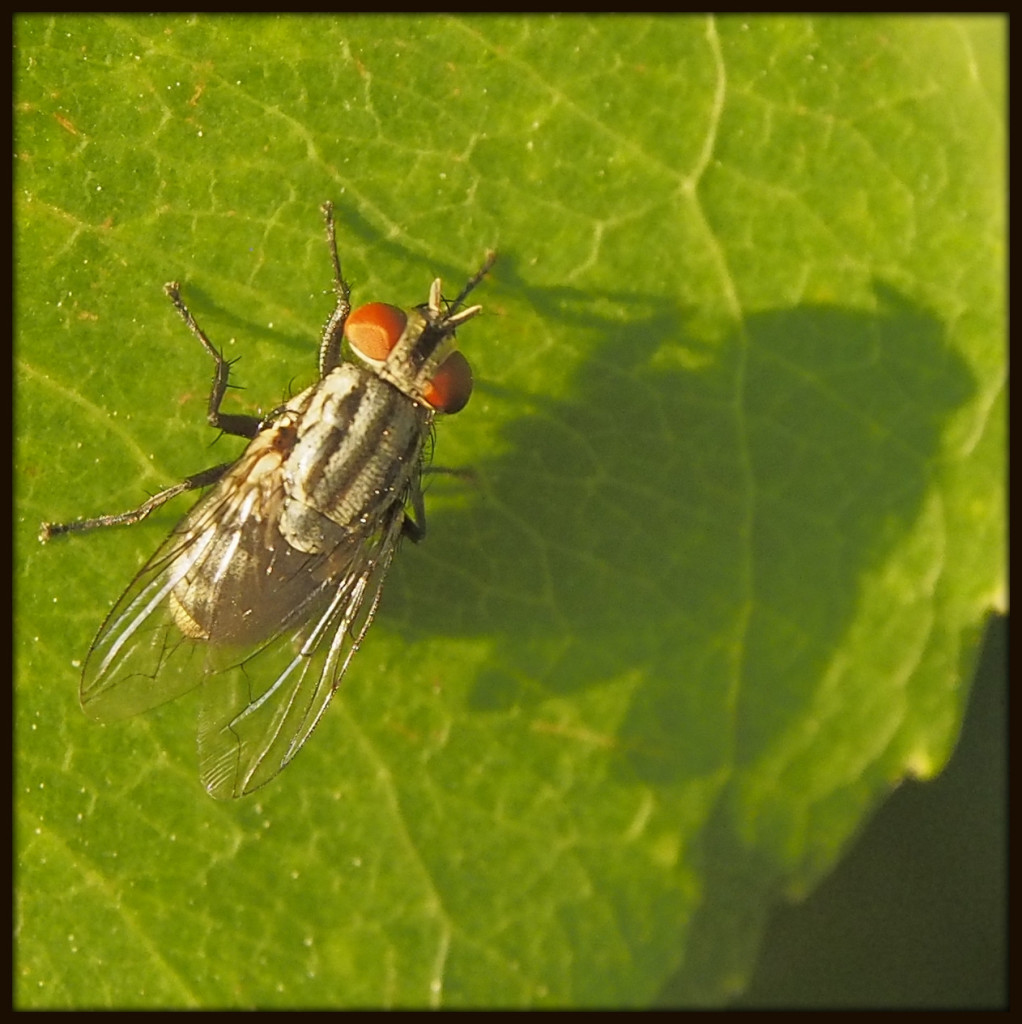
Our yard on Rico Road has become a haven for White-Tailed Deer (Odocoileus virginianus). Going up the driveway around sunset, I sometimes find half a dozen deer about. This time of year, I will often glimpse one or two hanging out beneath our pear tree, undoubtedly waiting for the pears to ripen. Lately, I have seen spotted fawns in the front yard. For all that, though, I have rarely seen deer along Piney Woods Church Road. Tonight, at last, almost as an afterthought — I had already taken plenty of photos on my walk, plus spent half an hour chatting with a friend who lives along the road — I glimpsed a pair of deer in a roadside pasture. By the time my camera was at the ready, the closer of the two was already preparing to flee. Still, the result is a pleasant image — and, at long last, deer are included among the Piney Woods Church images. There are so few wild mammal photographs out of the 187 so far. I can think of only one other photograph, in fact — and Eastern Gray Squirrel. Insects tend to be slower and more willing to sit still.

Here are the same three images from the previous post, all taken at Newman Wetlands Center on 4 July 2014, now in color instead of black and white. I am not sure which I prefer. Readers, what are your thoughts?
In taking these photographs, I have begun to appreciate that the woodlands of the Southeastern Piedmont offer inviting landscapes, as well — they are not limited to the Appalachians, seacoasts, and points West. Of course, this is something that Clyde Butcher has been showing us, through his spectacular photography in the Florida swamps, for many years now.
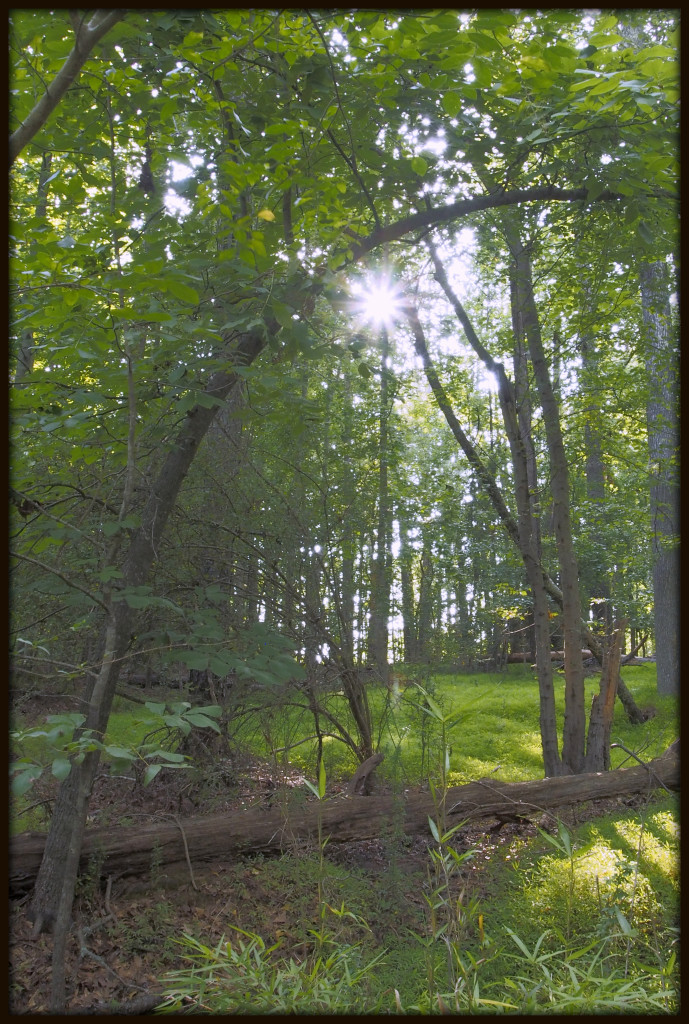
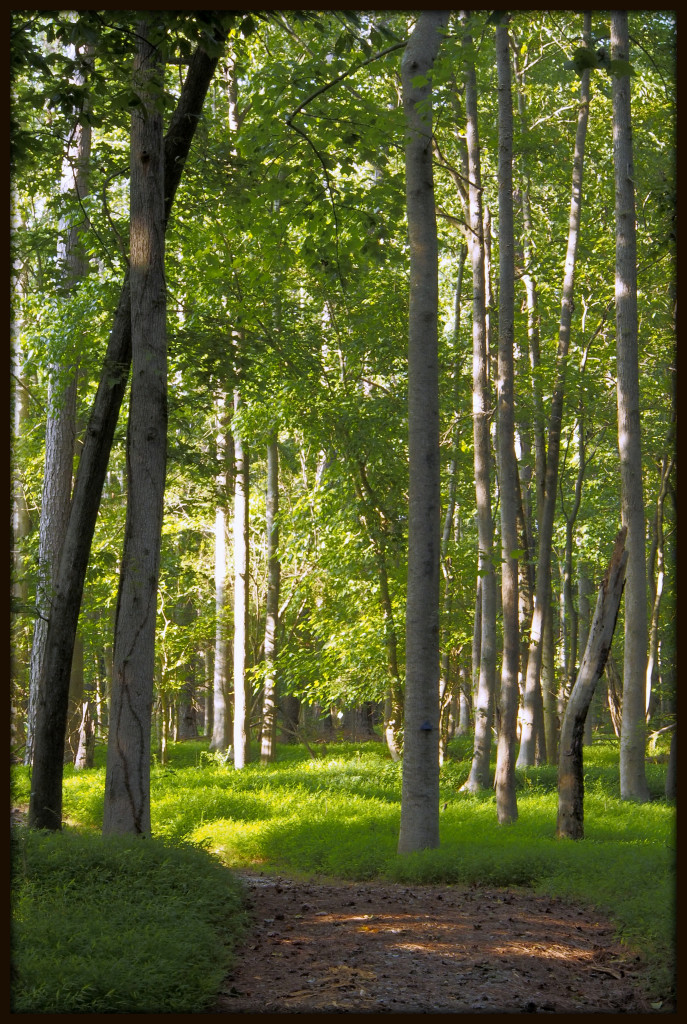
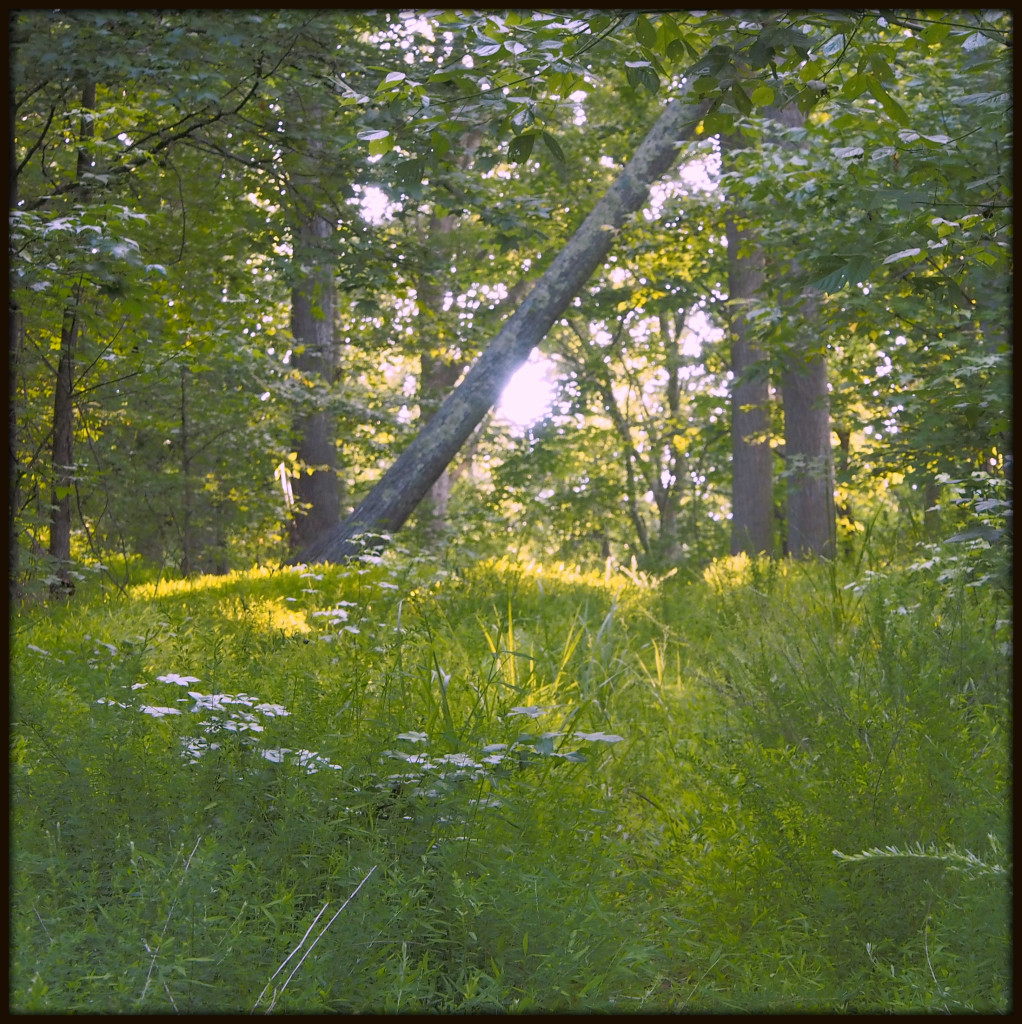
There is far more to Newman Wetlands Center (near Jonesboro, Georgia) than just the wetlands, stunning and teeming with life though they may be. On a sunny afternoon in early summer, a visitor might be surprised to discover enticing forest vistas illumined by sunlight. Much though I enjoy these photos with their rich greens, I find just as much allure in the simplicity of black and white. I will include the same images, in color, in a separate post.

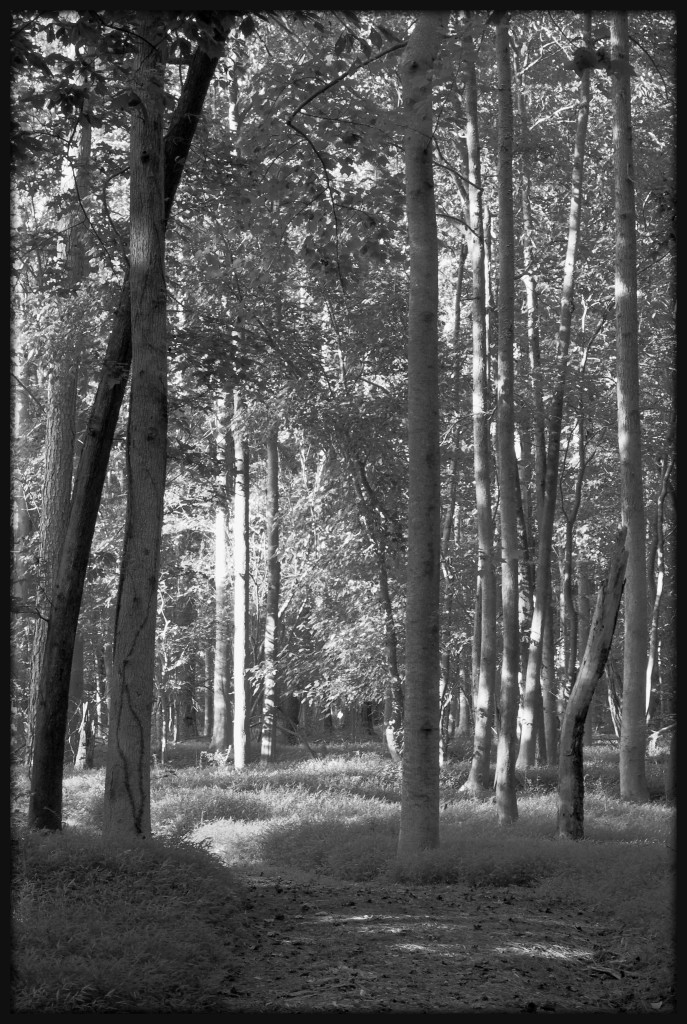
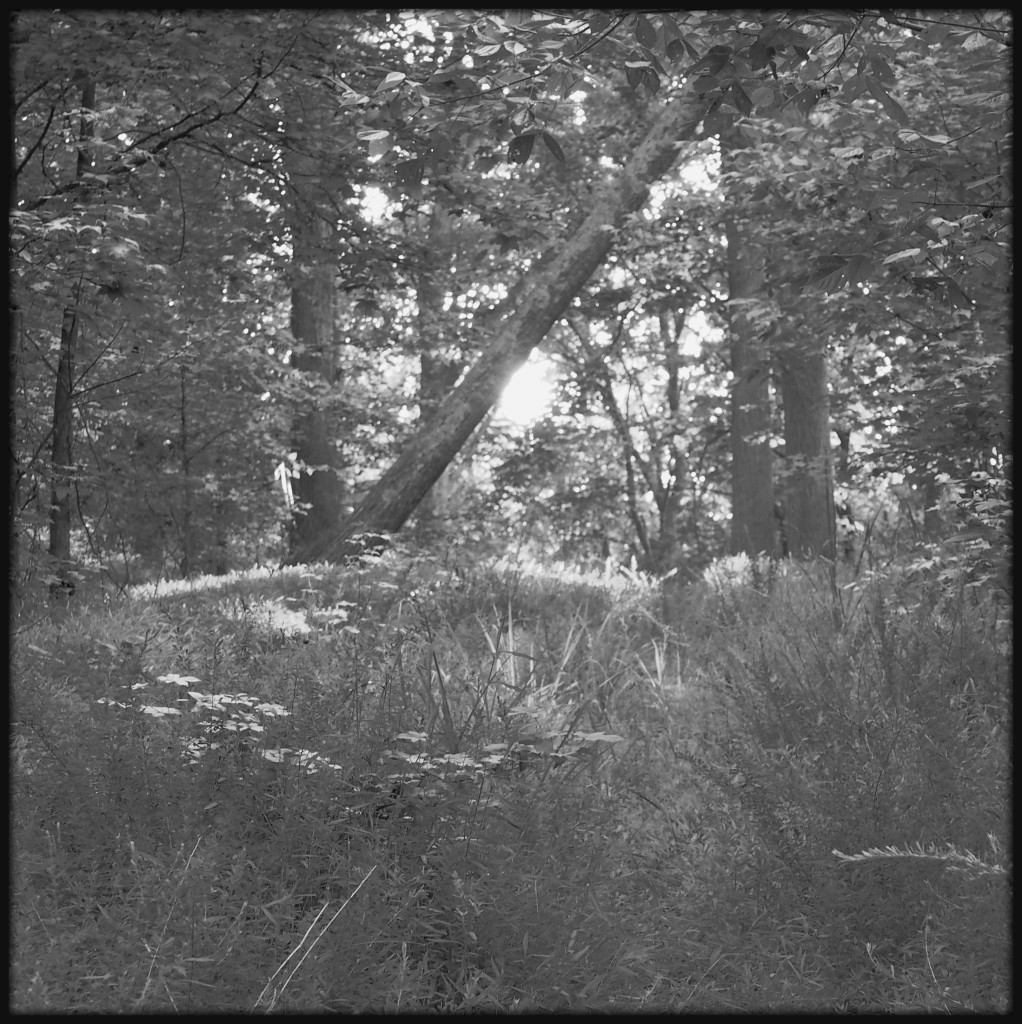
One of my first sights, upon entering a patch of woods adjacent to the wetlands at Newman Wetlands Center, was of an adult five-lined skink (Plestiodon fasciatus), a common species of lizard that is quite abundant on our back patio this time of year.
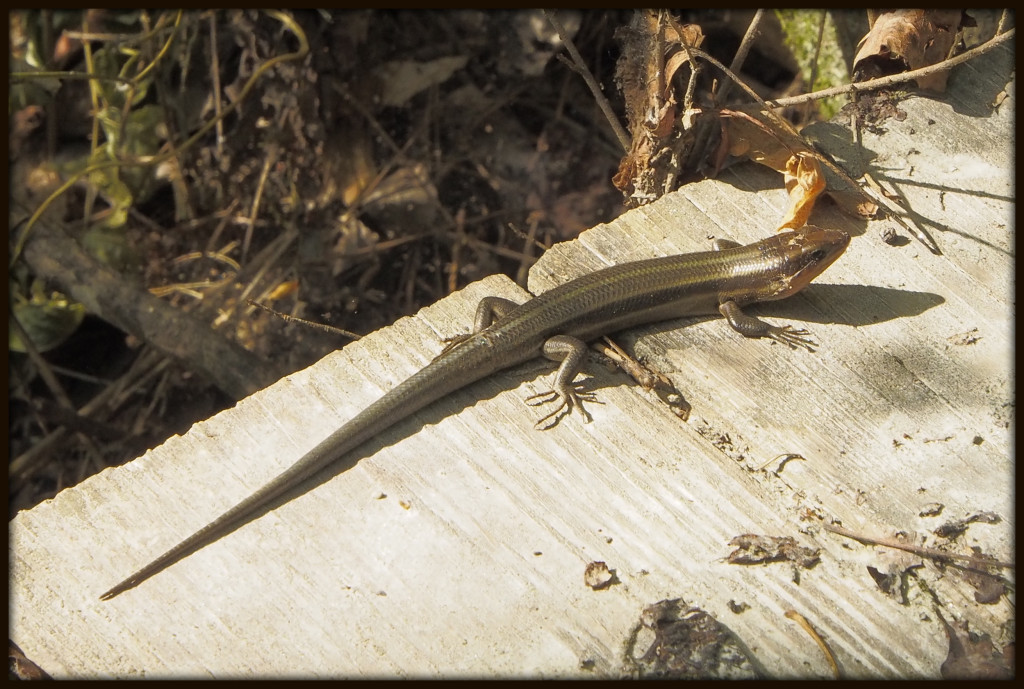
Along the first stretch of boardwalk, I encountered this red ant resting on the railing.

Continuing down the same stretch of boardwalk, I found a popular trailside perching area for Blue Dashers (Pachydiplax longipennis), a dragonfly species common in the Eastern United States.
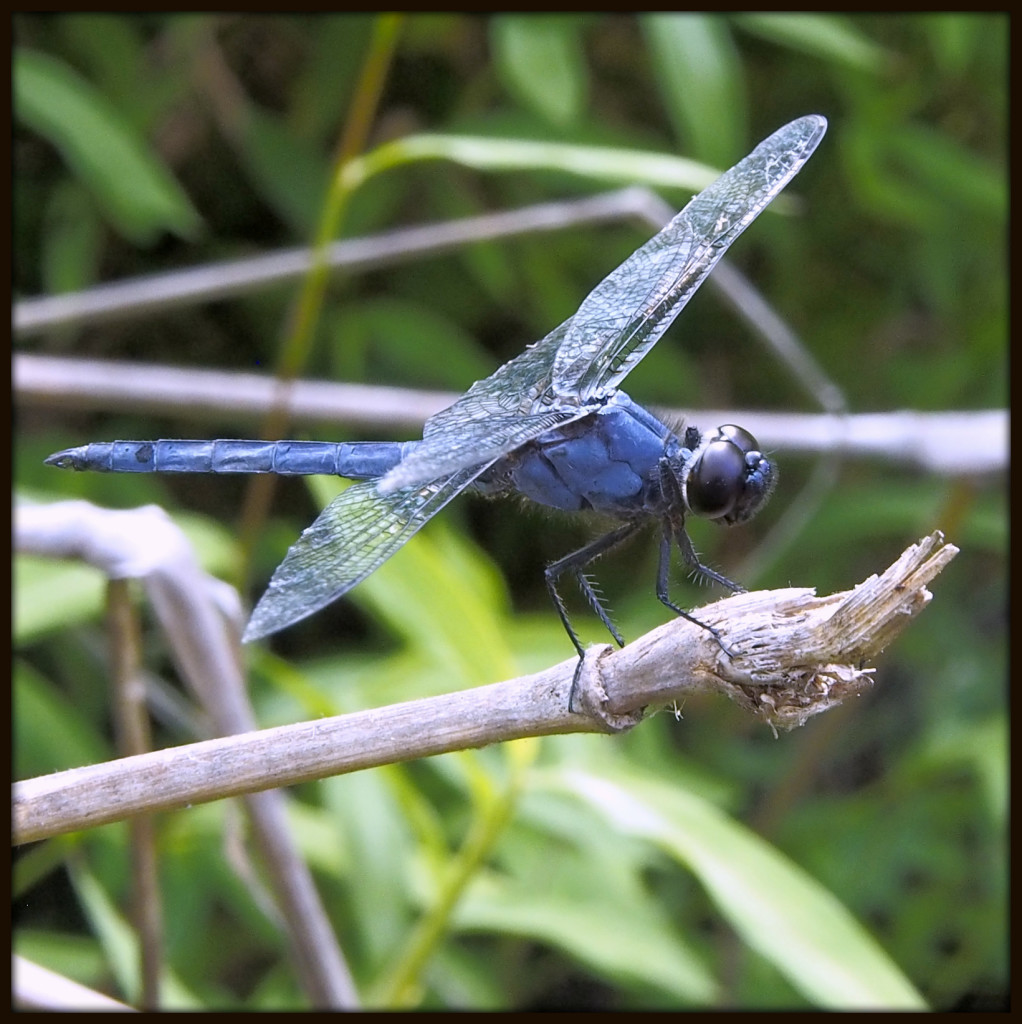
I try to be an equal-opportunity photographer, including a mix of good, bad, and ugly. When it comes to flies, though, I often hesitate. I am proud to say that I photographed this fly and added it to this blog, all the time thinking it was a vicious deer fly. Now I have to revise my opinion of this creature. According to folks at BugGuide on Facebook, it is actually a member of the family Bombyliidae, or bee flies. It is quite possibly Xenox tigrinus, or another member of that genus.

Further along, my next discovery was of another Blue Dasher willing to be photographed (the dragonflies were everywhere, but most darted too quickly from spot to spot, and/or had perches that were out of my camera’s macro range). This is my favorite dragonfly portrait of this particular outing. But I will be back again soon.
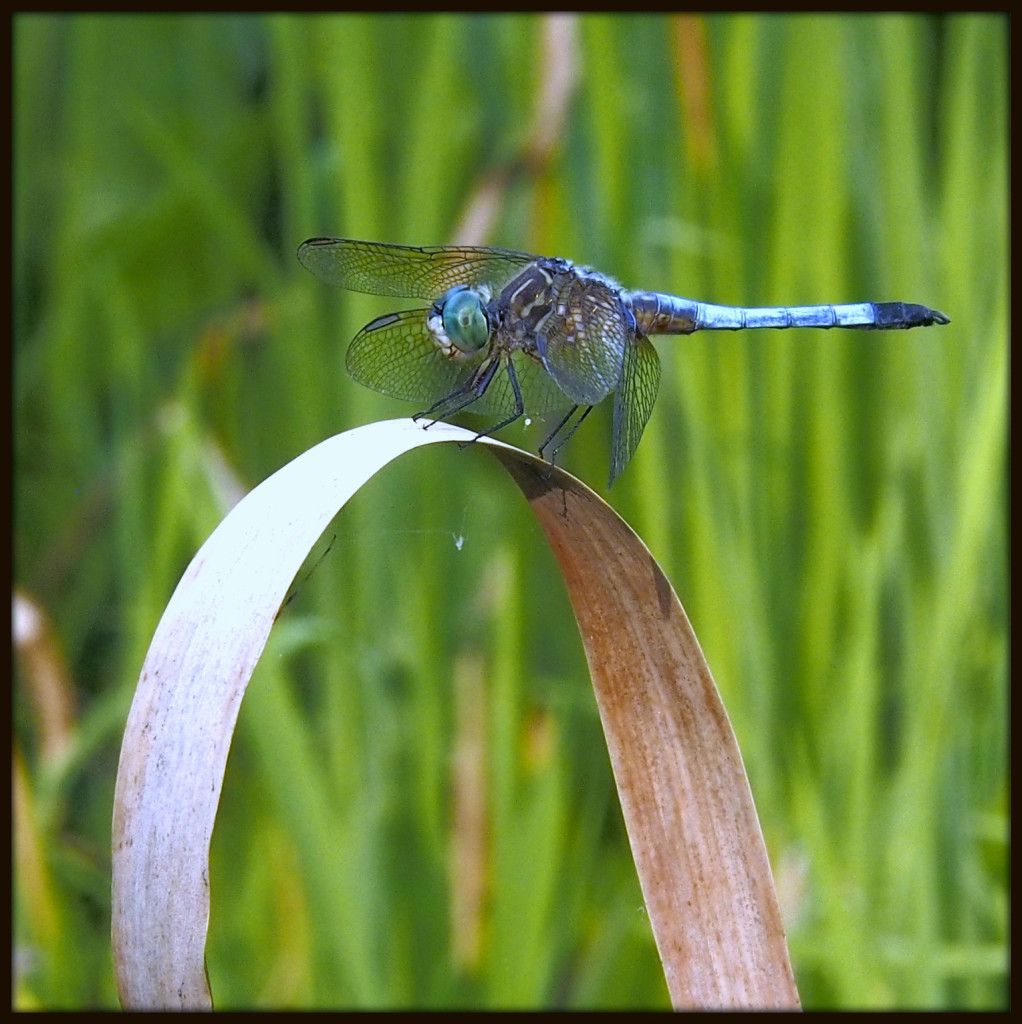
Stepping onto terra firma once again, we immediately saw this female Eastern Box Turtle (Terrapene carolina) in the path ahead. Valerie estimates her age at 75 to 100 years, and suspects that she may have been in search of a suitable location for laying eggs.
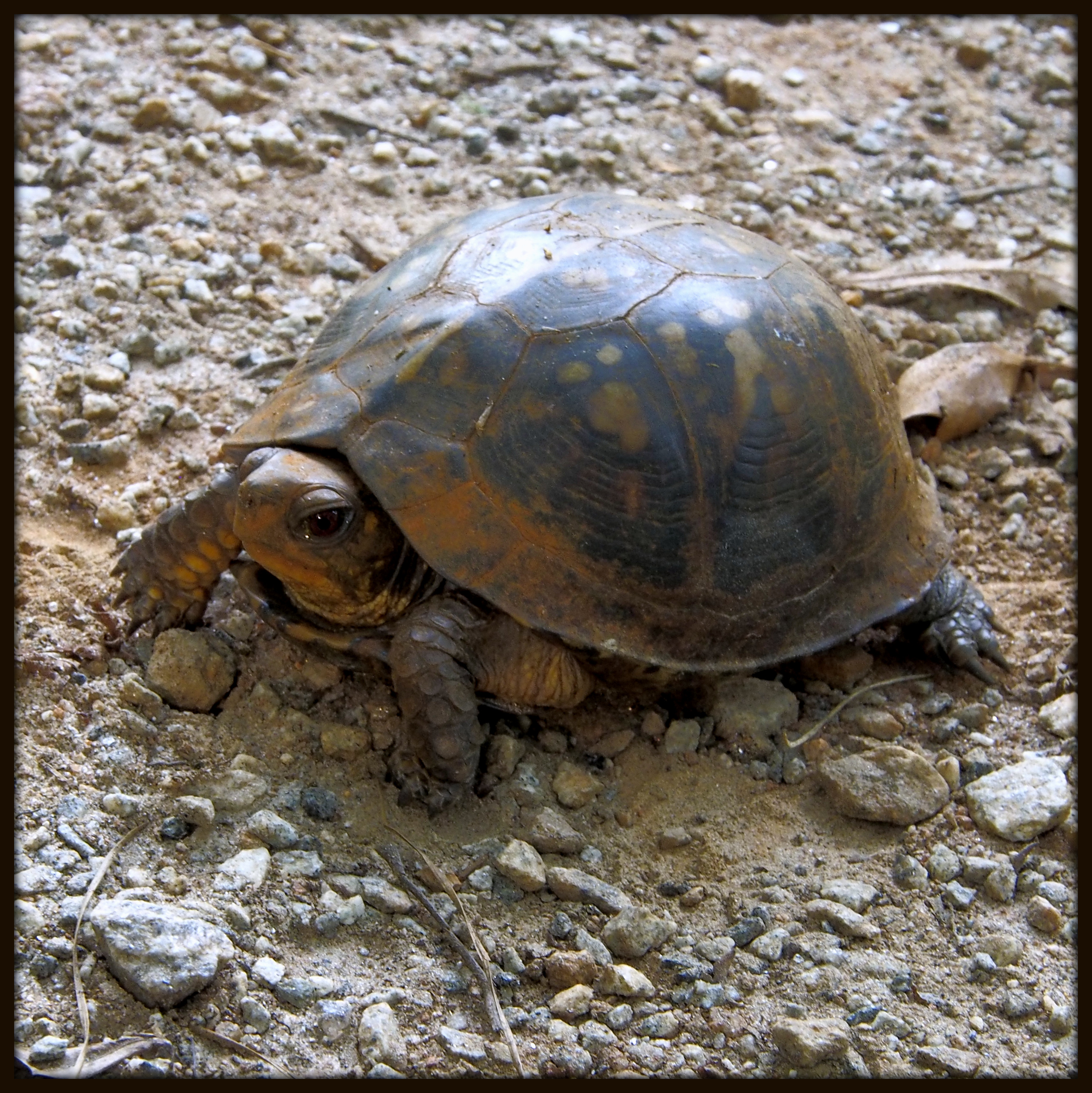
A short side spur led up the ridge, gaining about twenty feet in elevation and offering a view out over the wetland. In a tree hollow near the top, I glimpsed this insect, which was reluctant to be photographed. It is probably a Brown Lacewing (family Hermerobiidae).
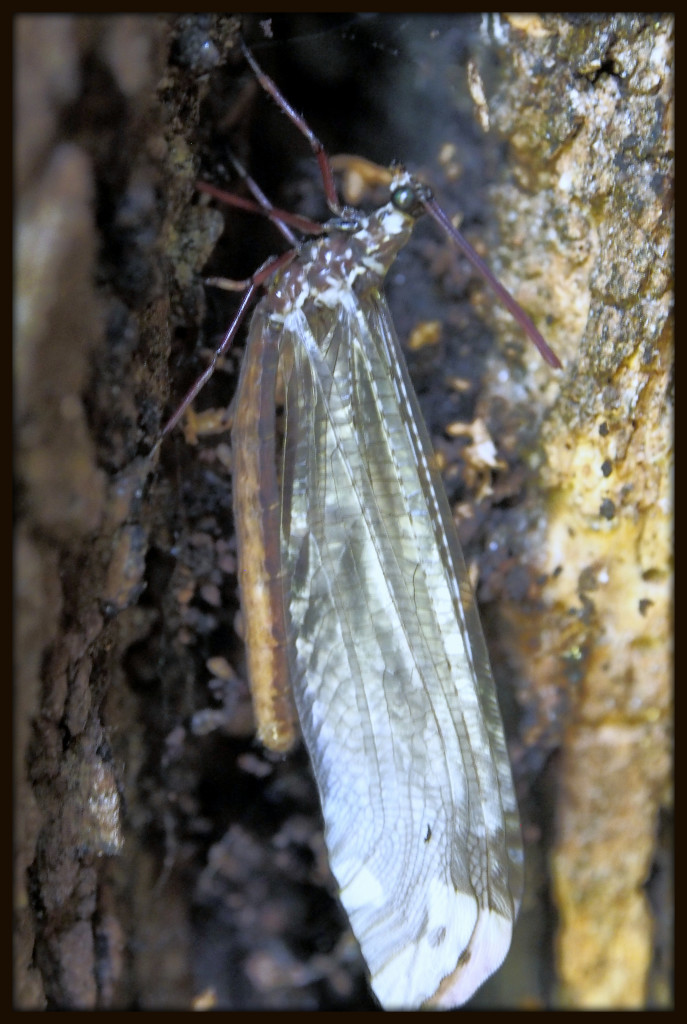
After so many photographs of insects (particularly dozens of dragonfly shots, nearly all Blue Dashers), I paused to take a couple of wetland plant photographs. The first one, I admit, I took because of all the Least Skippers feeding on it. The white globe of tiny flowers turns out to belong to the Buttonbush (Cephalanthus occidentalis). Now that I have a name for the flower, and appreciate how unusual it is, I ought to go back and photograph it properly!
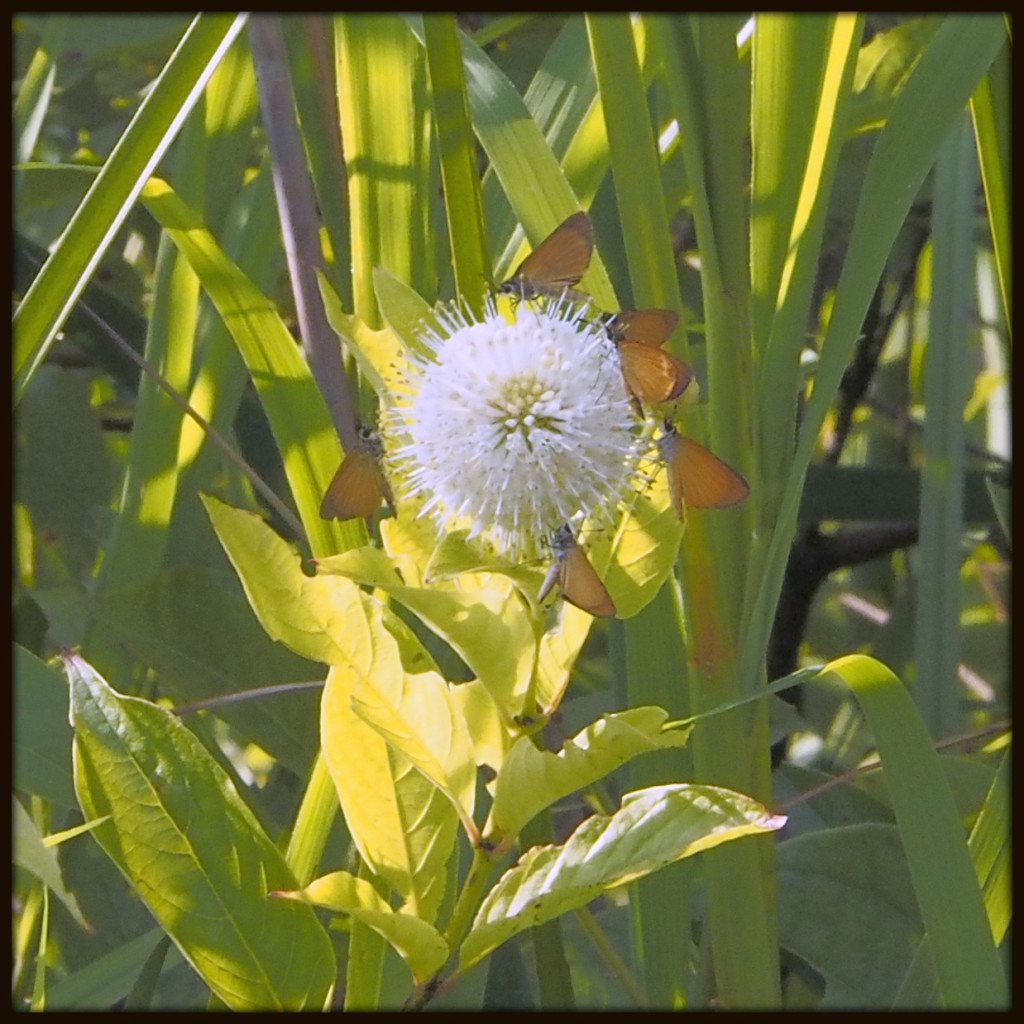
At last, a photograph simply in appreciation of the late afternoon sunlight shining through the underside of a leaf — in this instance, Common Arrowhead (Sagittaria latifolia).
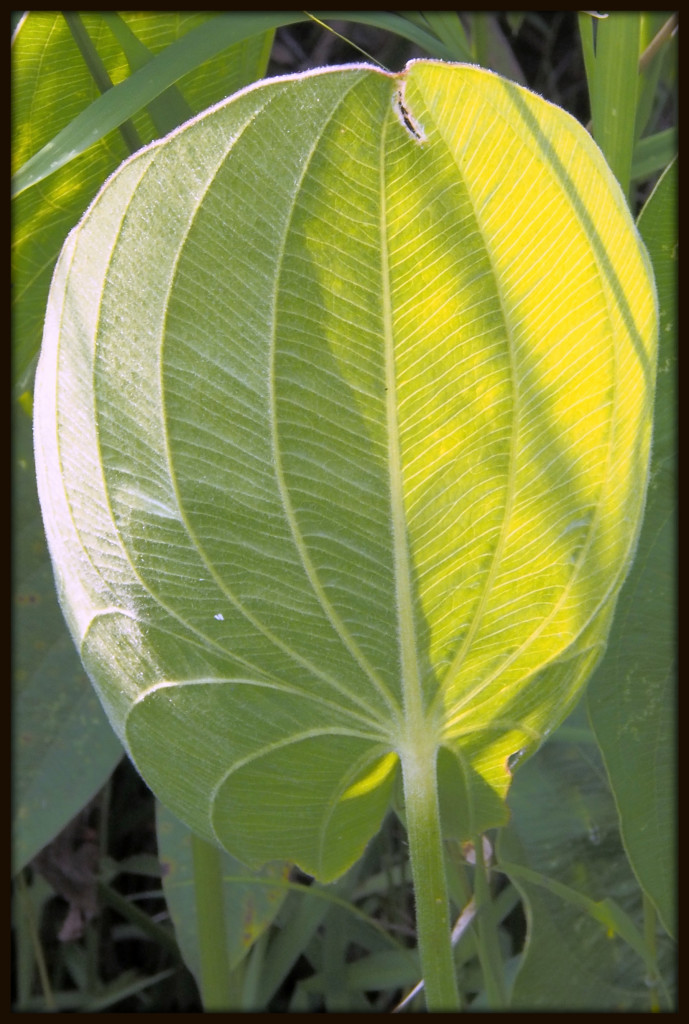
On one such Arrowleaf, an Ebony Jewelwing damselfly (Calopteryx maculata) was perched. Although these damselflies are often quite timid, this one allowed me to get quite close with my macro lens.

On a couple of occasions, the damselfly opened its wings for just a moment. I caught this once, but my 1/30-second exposure was too slow to avoid some blur to the wings.
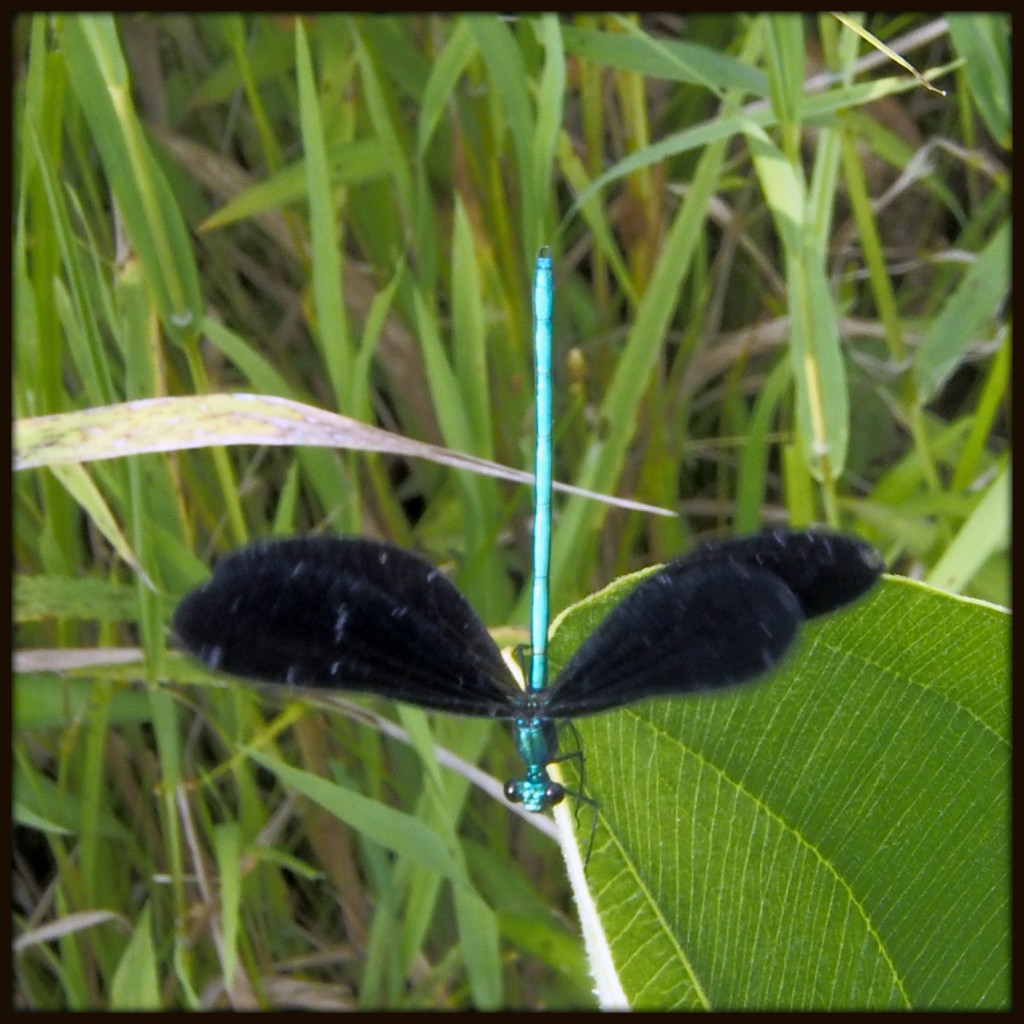
Nearing trails’ end, I paused to enjoy the reflection of wetland plants and dead branches in a pool.
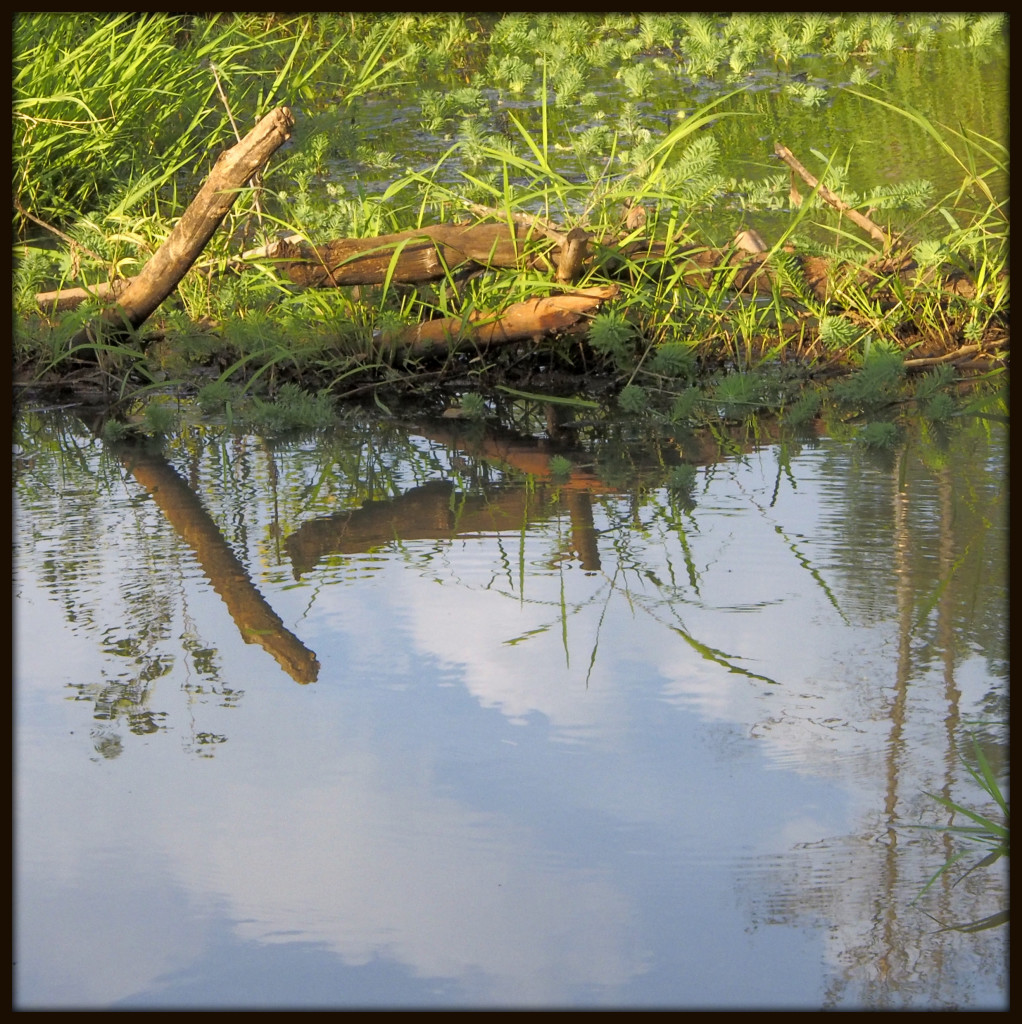
Just before the final section of boardwalk on the main loop trail, I saw an Eastern Gray Squirrel (Sciurus carolinensis)doing a bit of late-day feeding.
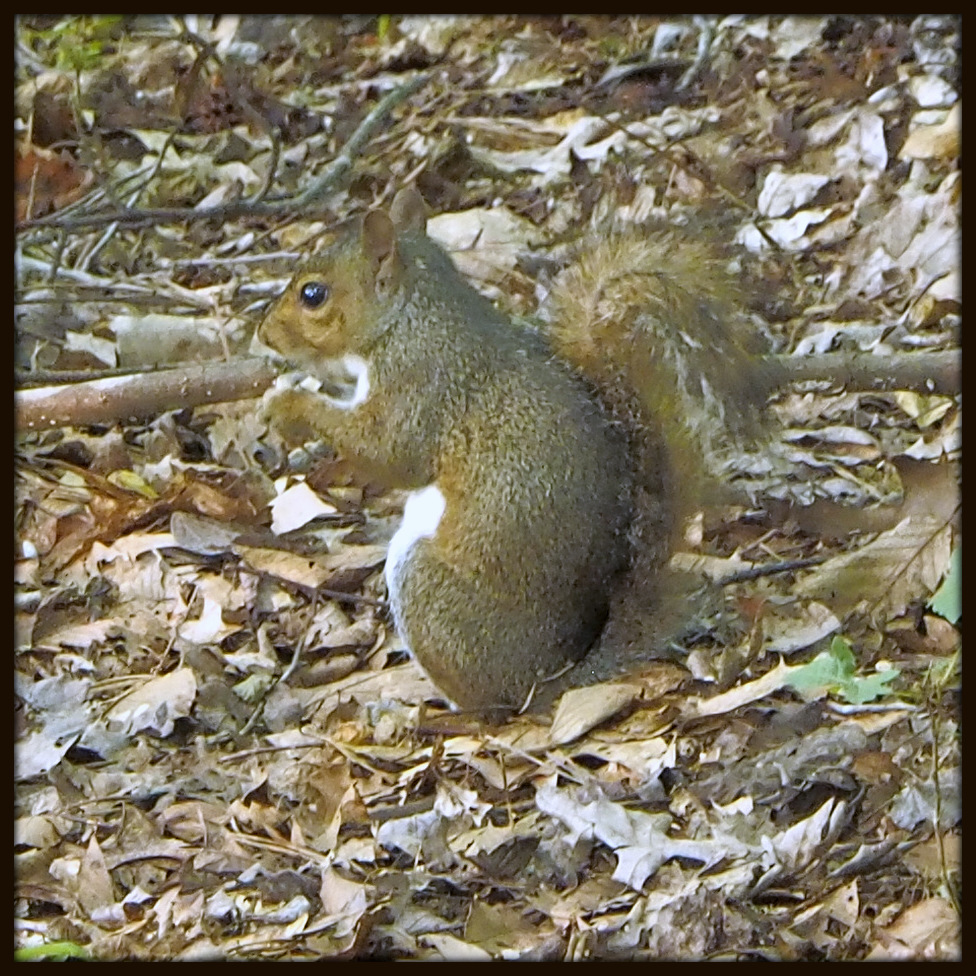
My ramble through Newman Wetlands took over two hours. In addition to the main loop, I also walked a few of the upland trails. There, wildlife was less abundant (or, at least, much less readily apparent). However, the sunlight through the trees afforded several stunning forest landscape photographs. These will be included in a Part Three post later today.
On the late afternoon of July 4th, Valerie and I journeyed to the Newman Wetlands Center in Hampton, Georgia, southeast of Atlanta and not far from Jonesboro. Clayton County Water Authority constructed a wetlands there, including a series of connected pools, as a means of managing treated waste water. The result is truly magnificent. It is among the most beautiful, species-rich, and healthy islands of wildlife that I have encountered in the Georgia Piedmont. The site includes about a mile and a quarter of trails, mostly boardwalk through the wetlands, with a couple of enticing loops onto adjacent ridges. There is so much to see there this time of year, from dragonflies and sunfish to turtles of all kinds, that anyone planning to take photographs should allow at least two hours to explore it all. There is also an extensive visitor center with an adjacent pollinator garden. This post features some of the insects seen in the garden; a separate post later today will cover the wetland wildlife.
Quite a few flowers were in bloom there last Friday, including several butterfly bushes (not a native species, but very popular with pollinators nonetheless). Purple coneflower (Echinacea purpurea) was also still flowering; though I did not see any insects land on them, the blooms were lovely enough to merit a photograph in their own right.
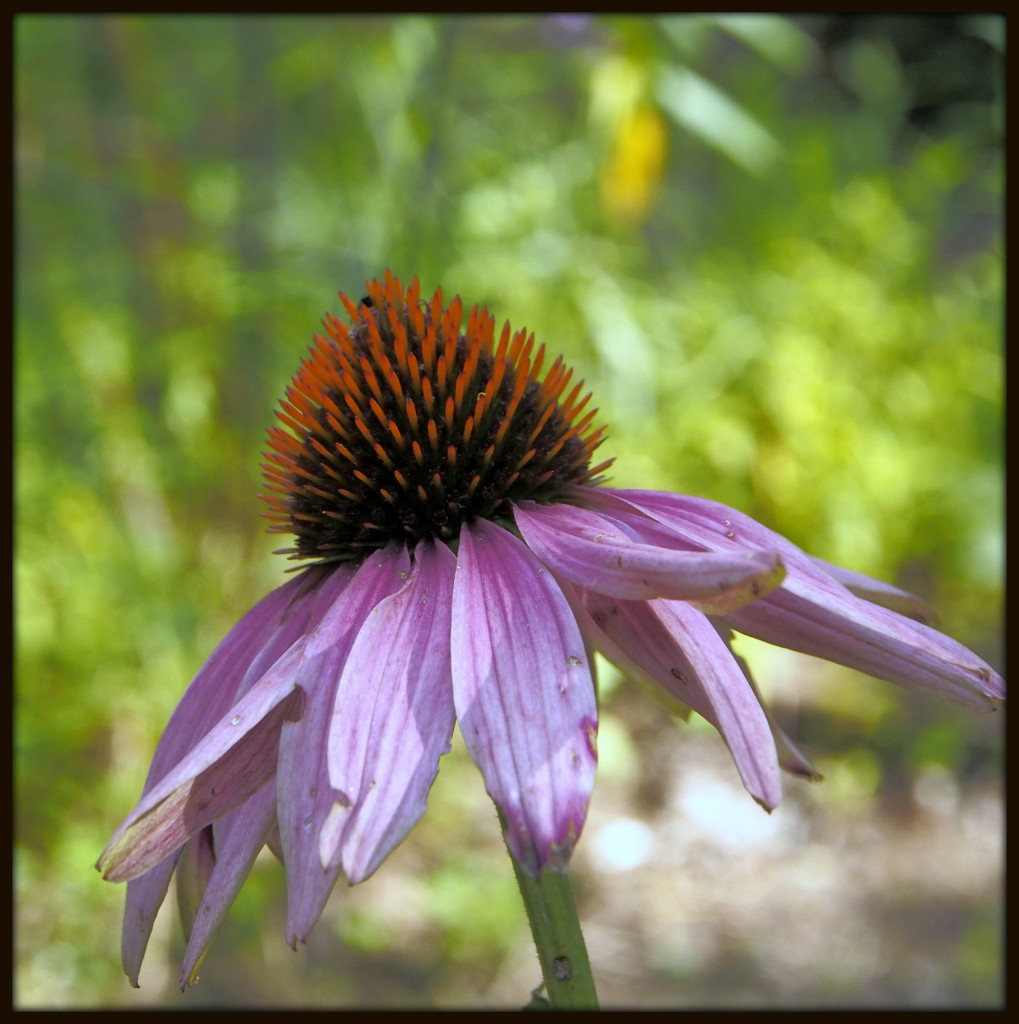
Bees were everywhere, and they were too busy gathering nectar to pay any attention to a photographer in their midst.

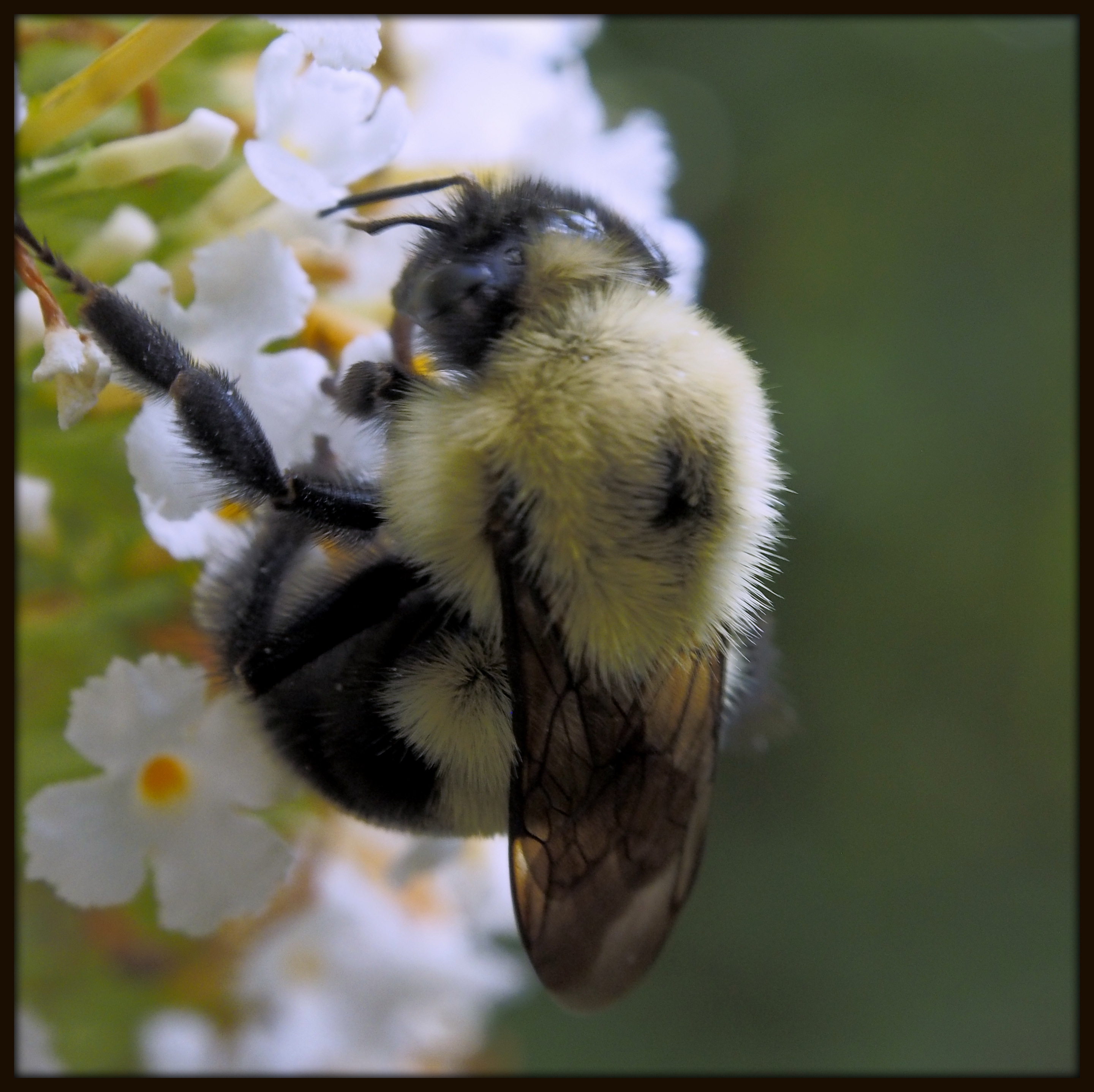
Small butterflies (Microlepidoptera) were in abundance, too. One was the tiny orange Least Skipper (Ancyloxypha numitor), with a wingspan of less than one inch. The Least Skipper may be found throughout the Eastern United States.
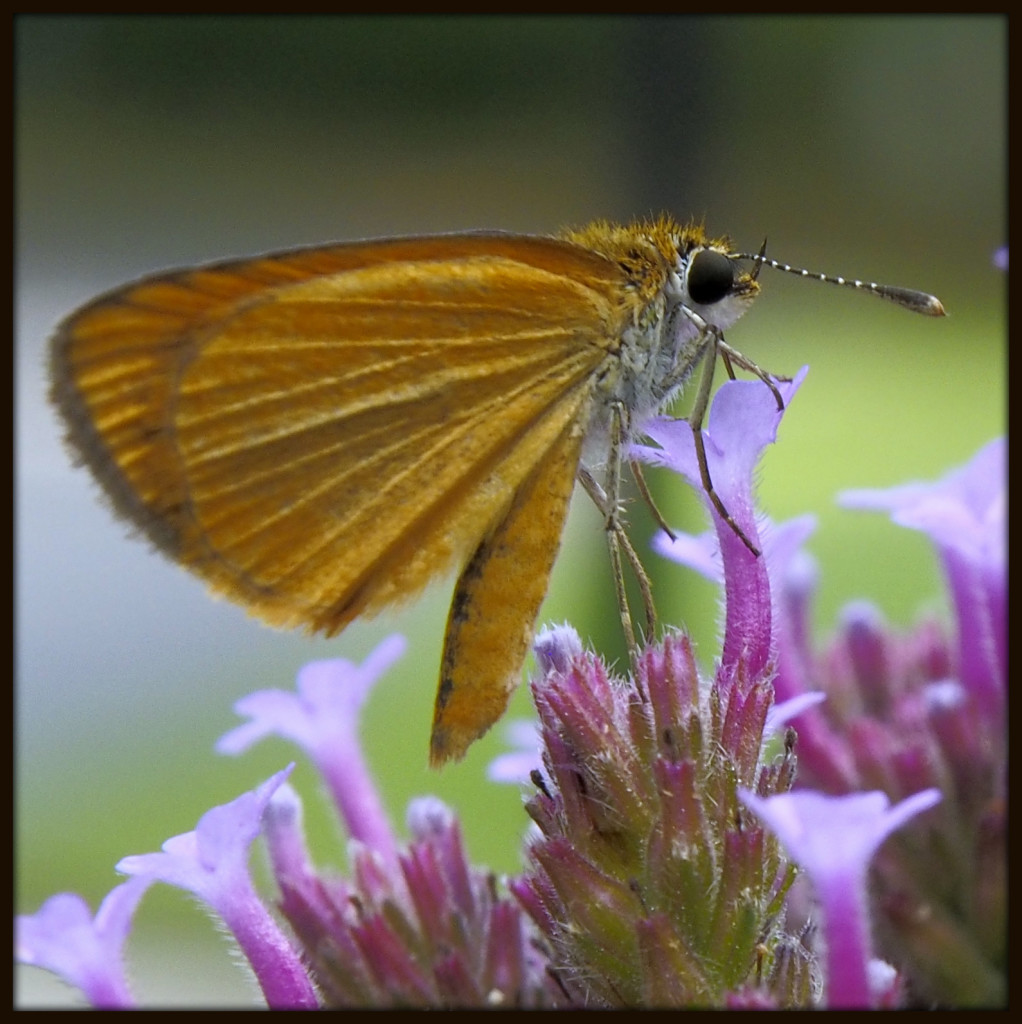
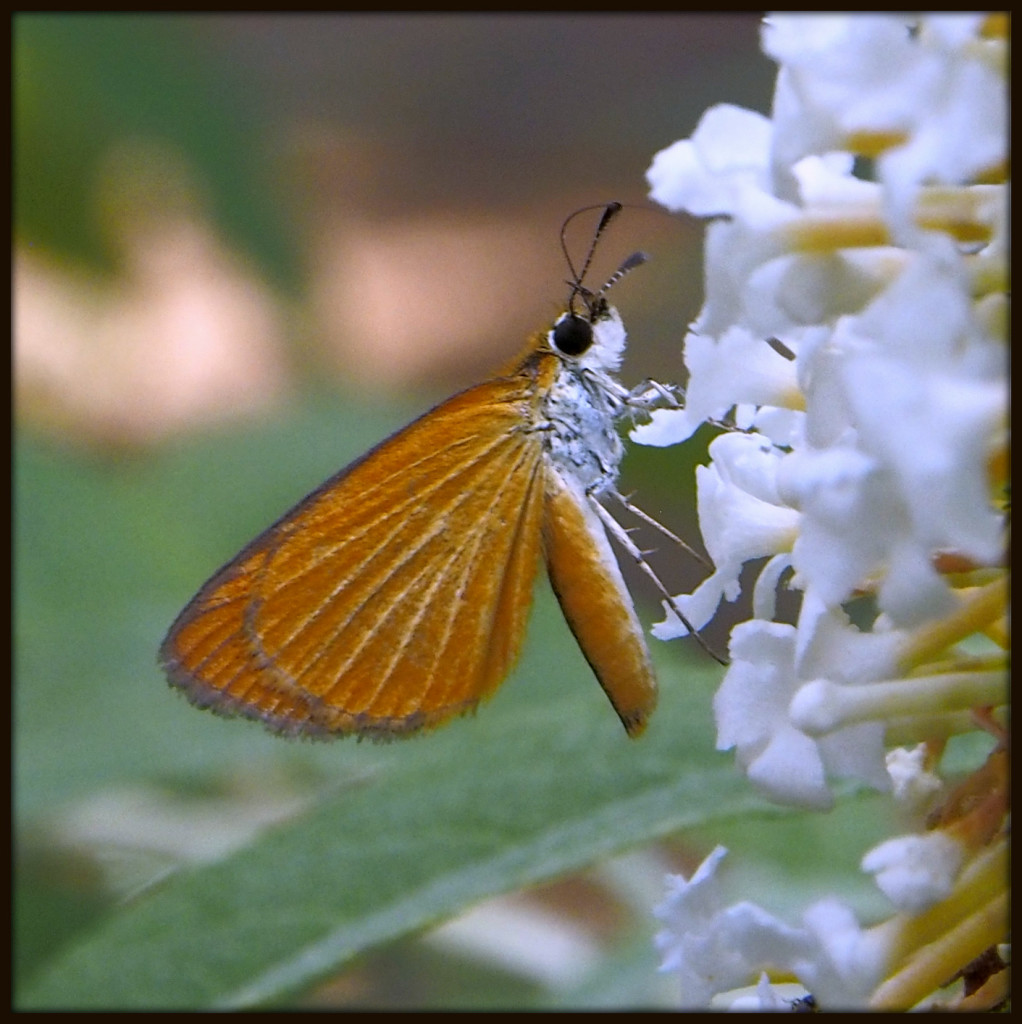
Another, slightly larger butterfly that was frequenting the pollinator garden was the chocolate brown Ocola Skipper (Panoquina ocola). A primarily tropical species common in the Deep South and found occasionally as far north as Pennsylvania, the Ocola Skipper has a one-and-a-half-inch wingspan.
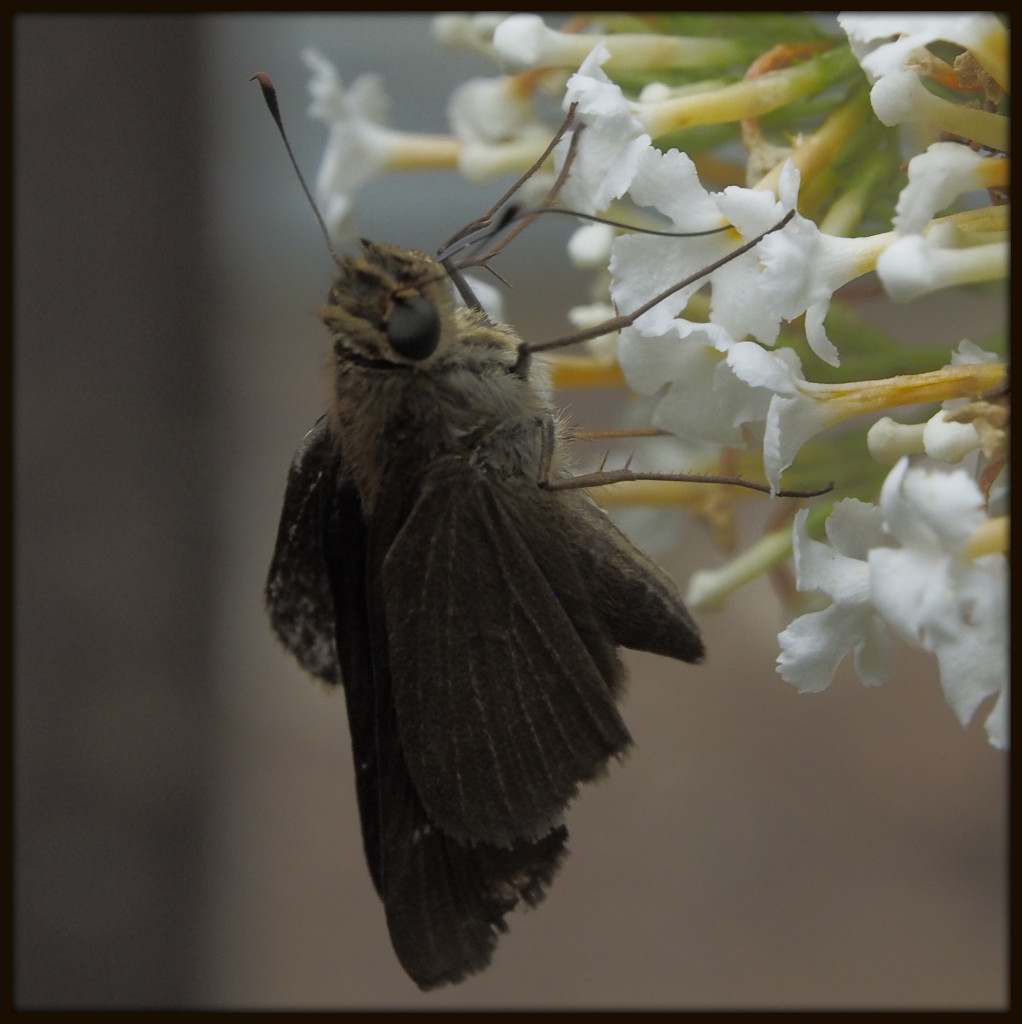
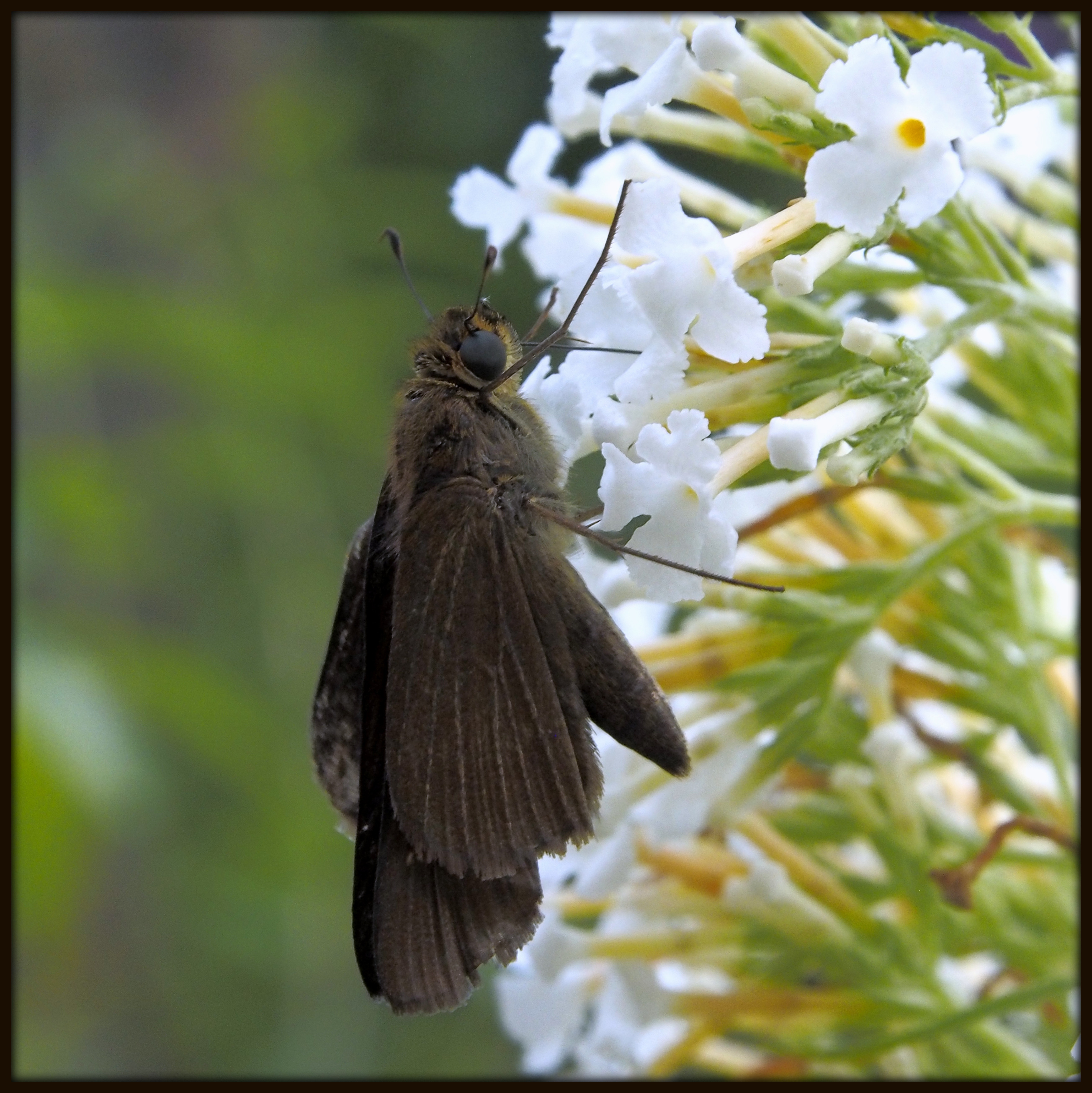
After half an hour entranced by the pollinators, I set off down the boardwalk trail and into the wetlands and adjacent woods.
On a hot and brightly sunny mid-afternoon, I captured this hoverfly resting for just a moment on a sweetgum leaf. I enjoyed watching it hover in midair, and imagined taking its picture in flight — ah, well, that is for another day. A bit further down Piney Woods Church Road, I glimpsed another one, busily gathering nectar from the ever-blooming daisy fleabane.

After several days of macro photographs, it felt marvelous to return to the human scale, with this photograph of the morning sun backlighting these pines and hardwoods along Piney Woods Church Road.
